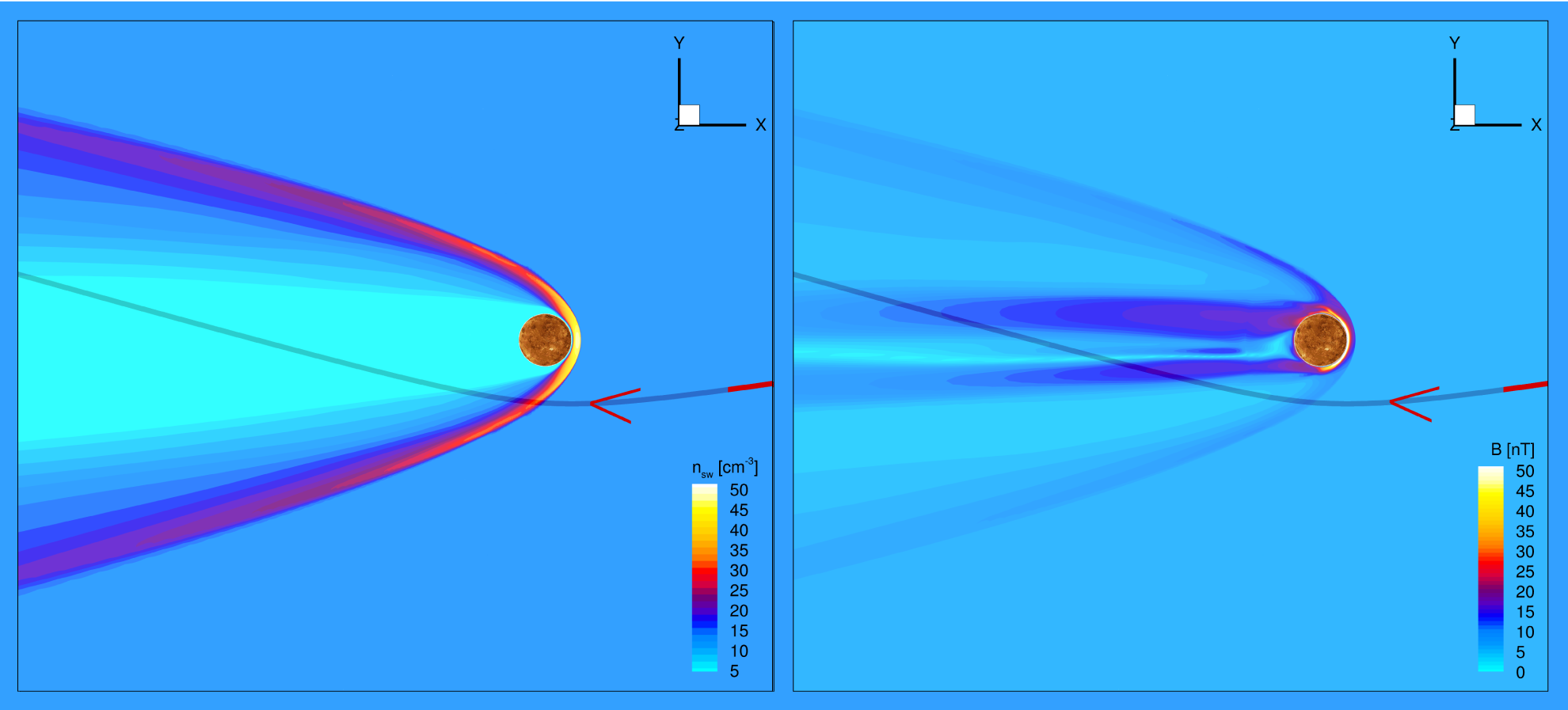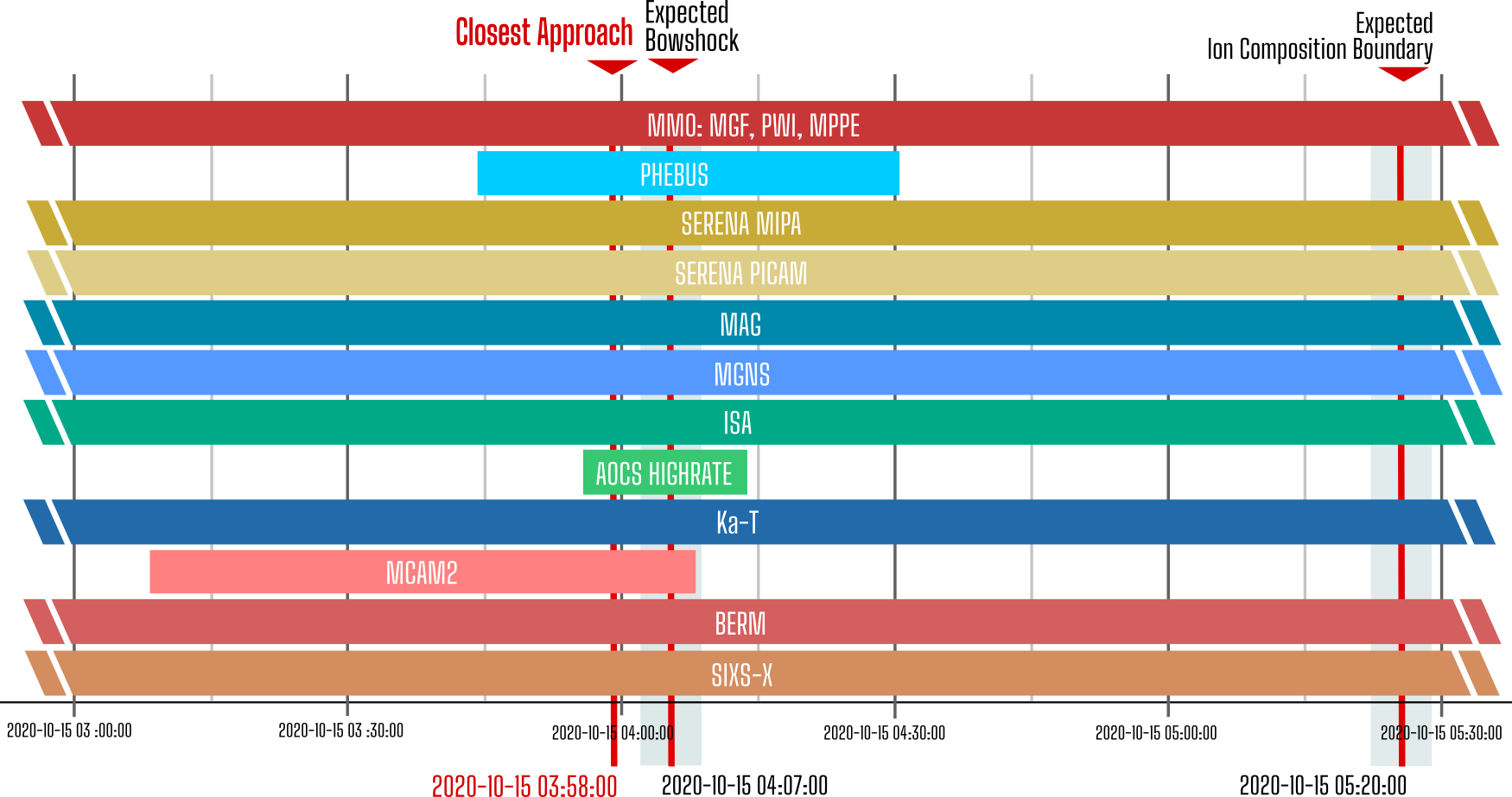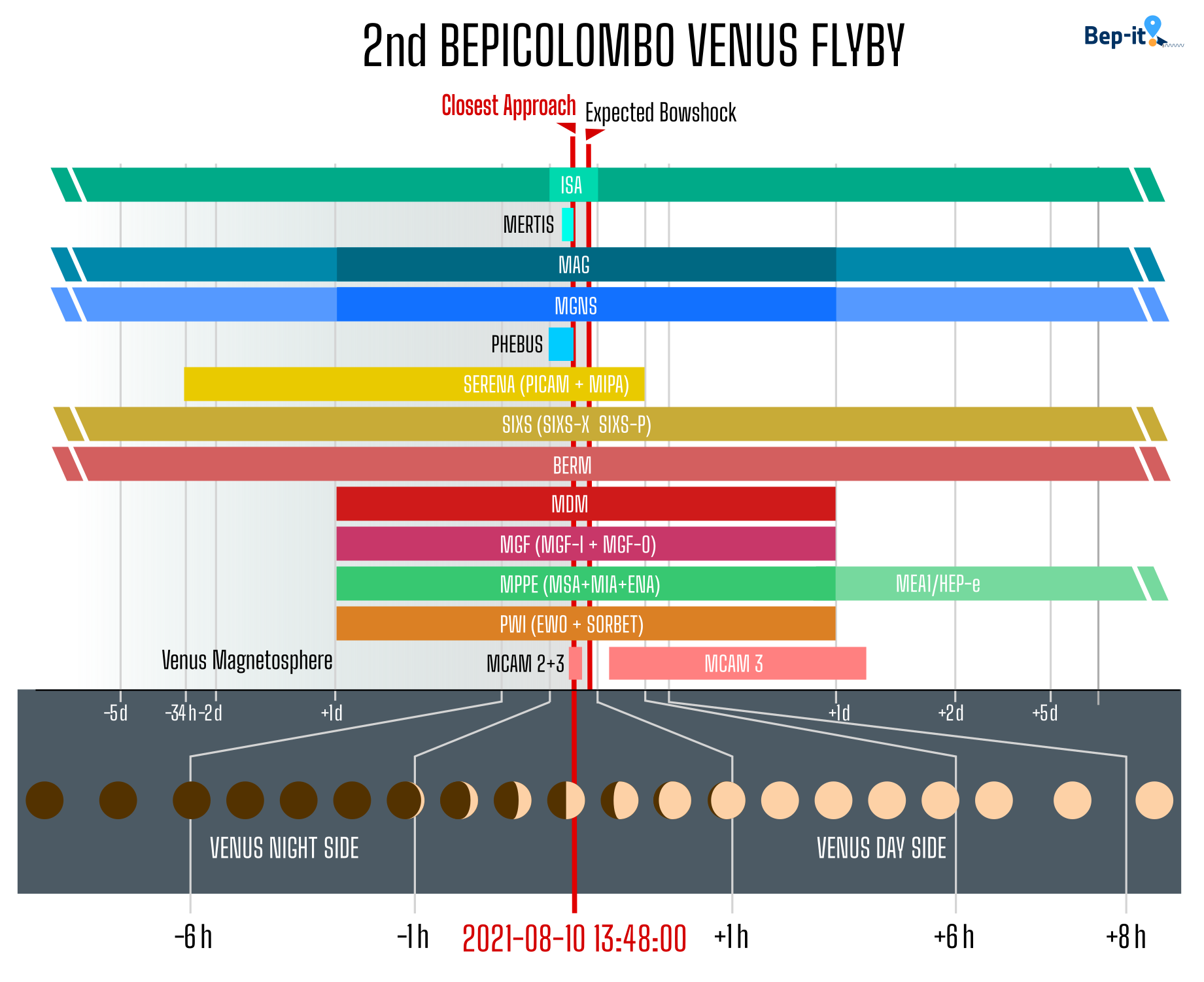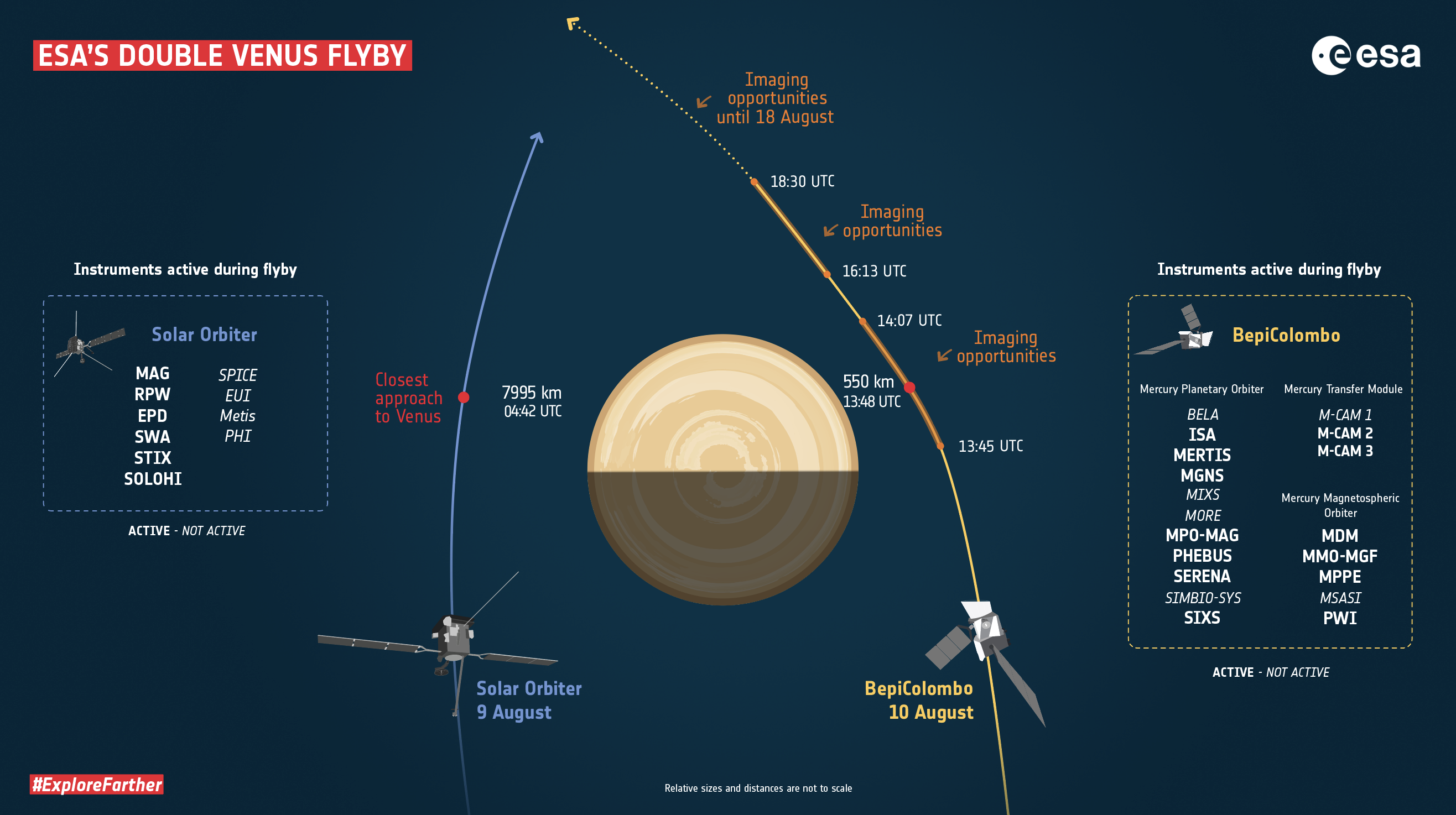Induced magnetosphere and ionosphere investigations

Figure 1: The trajectory of the first Venus flyby in X-Y plane (VSO system) superposed to the simulation of the expected solar wind/proton density (left panel) and magnetic field strength |B| (right panel). Note that the Sun is now on the right and the red part of the trajectory shows what lies above the X-Y plane (credits: Chuanfei Dong, Princeton University, New Jersey).
Given that Venus possesses no intrinsic dipole magnetic field, the solar wind plasma can easily approach the planet and interact directly with the upper atmosphere, leading to the formation of an ionosphere and a whole induced magnetosphere that surrounds the planet.
Simulations in Figure 1are obtained for average solar wind conditions and by means of the BATR-US code publicly availablehere, and it describes the most probable configuration expected during the BepiColombo flyby. Left panel shows the proton density as it increases in the subsolar region above the planetary surface, and along a wide shell around the planet that elongates in the anti-solar direction forming a wake. It also shows BepiColombo trajectory during the first flyby (in red the portion lying above the X-Y plane): it crossed the extended region of the different interactions occurring between the solar wind and interplanetary magnetic field on one side, and the planet Venus on the other. BepiColombo came from the Sun direction where there was the outer unperturbed solar wind, then crossed the bow shock, the compressed proton density region in the magnetosheath, the ion composition boundary, the ionosphere and finally went in the magnetotail. Simulation is also completed by the expected morphology of the planetary induced magnetic field in the X-Y plane (Figure 1, right panel).
The occurrence of the BepiColombo flyby at Venus on October 15th 2020, together with the presence of a suite of instrumentation (onboard both MMO and MPO) fully devoted to the magnetospheric studies, allowed a detailed study of the extent, interactions, magnetic and density discontinuities, of the many interactions occurring between the solar wind and the environment of Venus.
In fact, as it can be noted from the timeline below (Figure 2), all instruments (apart from PHEBUS) that were switched on during the bow shock crossing and the ion composition boundary:

Figure 2: Timeline of the operating instruments during 1st Venus flyby between October 15th 03:00 UTC and 05:30 UTC. Note the time of closest approach, the expected bow shock crossing shortly after at 04:07 UTC and the ion boundary composition crossing expected to happen at about 05:20 UTC (Credits: Carmelo Magnafico, INAF-IAPS, Rome).
The BepiColombo instruments involved for the Magnetospheric investigations at Venus are:
- MAG: the magnetometer (continuously operating during the cruise phase) will be run in high resolution mode (at 128 Hz) for the 48 hours around the closest approach, with the intent to measure the discontinuities of bow shock and other boundaries crossings; to measure the draped dayside magnetic field, low frequency wave activity inside the ion composition boundary, potential measurements of flux ropes and possible confirmation of the tail lobes with opposite magnetic field polarity;
- SERENA ion sensors PICAM and MIPA will be able to measure density and velocity of the ions populating the different regions crossed by the spacecraft trajectory (solar wind, bow shock, magnetosheath, ion boundary composition…). In particular, exactly for this purpose, MIPA will operate down to 72 hours after closest approach, to be able to detect also the exit crossing of the magnetotail;
- SIXS sensor SIXS-X may monitor the flare activity on the Sun, which could affect the atmosphere and exosphere of Venus. In addition, its observations can be used to search for the weak charge-exchange induced X-ray emission from the interaction between the solar wind and the Venus exosphere;
- BERM radiation monitor can provide info on the radiation environment through its electron, proton and heavy ions detectors;
- In addition, onboard MMO, the 5 sensors of MPPE are expected to provide measurements of electron shielding effects, atmospheric pick-up ions and energetic neutral atoms as derived from solar wind backscattering and/or ion sputtering over the exobase; they could help to relate the ionized and neutral components of the Venus environment, hence the induced magnetosphere with the atmosphere themselves. The 2 sensors of PWI and the MGF magnetometer will also be operative and provide additional measurements of the magnetic and electric fields around Venus (with possible detection of upstream foreshock waves, proton cyclotron waves, magnetosheath turbulence…);
The collection of all these measurements would then be of great interest to determine the position and extent of the bow shock (depending on the solar wind and interplanetary magnetic field condition at the moment of the flyby) and the other boundaries; to provide additional information on the electron and ion populations at different energies, and on the occurrence of some of the interactions mechanisms known to exist inside the induced magnetospheres.
Hence, the listed measurements, apart from being interesting investigation by itself, will also be important complement for:
- the space weather studies, as related to the interplanetary magnetic field and solar wind and radiation propagation and interaction with the planet Venus;
- atmospheric studies (i.e. atmospheric escape and ionosphere dynamics), for it will provide crucial information on the outer part of the atmospheric interactions with external radiation and ion and electron populations.
2nd Flyby Magnetospheric Investigations and Coordination with Solar Orbiter
Contrary to the 1st flyby, during the 2nd flyby of August 10 2021, BepiColombo will approach Venus from the tail side; then, it will encounter the planet at a minimum distance of about 550 km on the evening side (similar to the previous flyby), and finally it will pass by Venus exiting from the front side of the bow shock (see Figure 3: follow the blue line in the image below, from right to left).

Figure 3: Venus flybys trajectories in XY plan, VSO system (Credits: Markus Fraenz, MPI, Goettingen, Germany). Bepi I,red and Bepi II, blue are for 1st and 2nd flybys trajectories, respectively. Note that Y axes are increasing downwards. Units are in Venusian Radii.
From the point of view of the magnetospheric investigations then, it will explore a long region of the magnetospheric tail that lies in between the bow shock and the ionopause, whose shape and extent strongly depends on the solar wind conditions at the time of the flyby. Hence, it will have the possibility to investigate a whole series of events that may occur in these boundary regions.
If we plot the timeline of the instruments to be operated during the flyby together with the previous cited regions to be crossed (Figure 4), we may see that the above described instruments (magnetometers, ion, electron and plasma sensors) will acquire data during the whole period of interest, starting from the far tail, the flanks of the bow shock/ionopause, and finally the external solar wind. In addition to the instruments used during the first flyby, there will be PHEBUS, SIXS-P sensor, and the MDM (the dust monitor) on board MMO.
The regions expected to be crossed during the flyby are also shown

Figure 4: Timeline of the operating instruments in the days around the 2nd Venus flyby on August 10 2021 (Credits: Carmelo Magnafico/Valeria Mangano, INAF-IAPS, Rome).

Figure 5: The infographic by ESA created for the BepiColombo and Solar Orbiter ‘almost’ joint Venus flybys on 9 and 10 of August 2021. Instruments that will be operated on both spacecraft are listed too. Nb: distances of the probes are not in scale. Credits: ESA.
The second flyby of BepiColombo will be a special event not only for itself, but also because it will occur 1 day after the Solar Orbiter the Venus flyby on 9 of August 2021 (with closest approach at 04:42 UTC and minimum altitude of about 7995 km).
Hence, in addition to the expected coordination among the different instruments onboard BepiColombo, further coordination with the Solar Orbiter spacecraft is planned with the goal to take advantage of different interesting spacecraft configurations between the two probes:
- Both spacecraft in the wake with two different vantage points;
- Solar Orbiter in the induced magnetosphere and BepiColombo in the far tail/wake;
- Solar Orbiter in solar wind and BepiColombo still inside the planetary magnetosphere.
This is a unique opportunity for Venus scientists to have information of different regions of its environment, and investigate the cause-effect relationship of the different phenomena/boundaries/populations that will be measured.
The Solar Orbiter instruments of particular interest for the coordination with BepiColombo are the following:
- EPD (Electron Particle Detector): to study composition, timing and distribution functions of energetic particles
- MAG (magnetometer): high-precision measurements of the magnetic field
- RPW (Radio Plasma Wave instrument): electromagnetic and electrostatic waves, magnetic and electric fields at high time resolution
- SWA (Solar Wind Analizer): sampling protons, electrons and heavy ions in the solar wind.>
The X-ray imager STIX and the heliospheric imager SoloHI will complement the information for further interaction that may come from the Sun.
Coordinated analysis can be summarized into 4 different steps, as the two spacecraft proceed in their flybys:
Step 1: the two spacecraft approaching Venus from the nightside to monitor the boundaries and tail region processes: (SolO CA -3 days up to SolO Ca -12 hours). In this phase, it will be possible to investigate:
- solar wind-Venus coupling on large scales in the night region, solar wind structures effects on large scales (if detectable and if occurring during passage);
- Tail region processes, scaling properties and dynamical regimes, non-stationary features and coupling mechanisms.
Step 2: MAG during VFB2 within the Venus environment (SolO CA ± 12 hours). In this phase it will be possible to:
- Investigate in-situ processes characterizing Venus environment in terms of particle precipitation mechanisms, inertial/ion-kinetic effects, reconnections, ionospheric electrodynamics
Step 3: SolO crossing the magnetopause and bow shock and exiting in the solar wind (while Bepi is still in the Venus magnetosphere) (SolO CA ± 3 hours). During this phase it will be possible to investigate:
- Big scale boundary processes between ionopause and bow shock;
- Small scale processes and structures (i.e. turbulence, cascate rates, magnetic holes/plasmoids, instabilities, electric currents…) at MHD and kinetic scales between ionopause and bow shock.
Step 4: SolO in the solar wind until Bepi is out (SolO Ca ±1 day up to 7). In this last phase, it will be possible to:
- Monitor external solar wind conditions (velocity, dynamic pressure…); possible detection of released particles;
- Study small scale processes and structures (i.e. turbulence, cascade rate, magnetic holes, instabilities…) at MHD and kinetic scales in the solar wind.
More INFORMATION
- The BepiColombo mission to Mercury: special issue on Space Science Reviews 2020 here (and in particular the BepiColombo cruise & flybys science paper).
- ESA COSMOS page on BepiColombo instrumentation here.
- JAXA press release on first results of Mio instrumentation (MPPE and PWI) for the first flyby is available here.
- ESA Solar Orbiter page here
- The Solar Orbiter special issue on Astronomy and Astrophysics 2020 here








































 Sign in
Sign in
 Science & Technology
Science & Technology